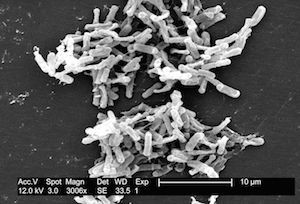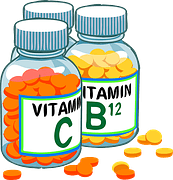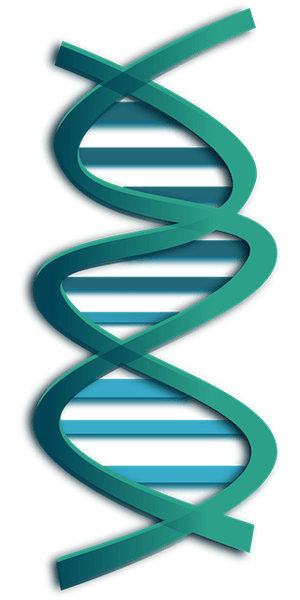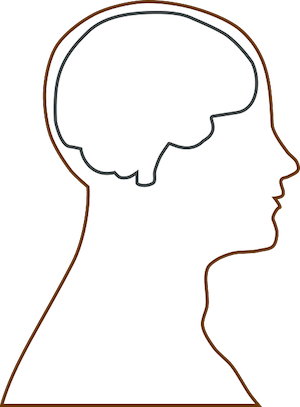The intestinal dysbiosis
 The intestine-brain relationship and the fact that the intestine is the second brain is widely accepted by the community of alternative medicine. The GAPS therapy by Dr. Campbell-McBride, for example, is based on this principle.
The intestine-brain relationship and the fact that the intestine is the second brain is widely accepted by the community of alternative medicine. The GAPS therapy by Dr. Campbell-McBride, for example, is based on this principle.The intestinal dysbiosis is an imbalance between physiological or symbiotic and opportunistic or pathological intestinal flora. It is based on the effect of the neurotoxins on the brain. These neurotoxins are produced by pathological and undesirable bacteria that are installed in the intestine, some of which are neurotoxic, such as the alcohol produced by yeast, such as Candida, toxins similar to tetanus produced by Clostridium tetani, and certain poisonous substances like dermorphin and deltorphin whose origins are still unknown. (1)
Dr. Campbell-McBride refers to the pernicious effect of yeast as follows:
“The most common pathogenic microbes shown to overgrow in the digestive systems of children and adults with neuro-psychiatric conditions are yeasts, particularly Candida species. Yeasts ferment dietary carbohydrates with production of alcohol and their by-product acetaldehyde. Let us see what a constant exposure to alcohol and acetaldehyde does to the body:
* Liver damage with reduced ability to detoxify drugs, pollutants and other toxins.
* Pancreas degeneration with reduced ability to produce pancreatic enzymes, which would impair digestion.
* Reduced ability of the stomach wall to produce stomach acid.
* Damage to immune system.
* Brain damage with lack of self-control, impaired co-ordination, impaired speech development, aggression, mental retardation, loss of memory and stupor.
* Peripheral nerve damage with altered senses and muscle weakness.
* Direct muscle tissue damage with altered ability to contract and relax and muscle weakness.
* Nutritional deficiencies from damaging effect on digestion and absorption of most vitamins, minerals and amino acids. Deficiencies in B and A vitamins are particularly common.
* Alcohol has an ability to enhance toxicity of most common drugs, pollutants and other toxins.
* Alteration of metabolism of proteins, carbohydrates and lipids in the body.
* Inability of the liver to dispose of old neurotransmitters, hormones and other by-products of normal metabolism. As a result these substances accumulate in the body, causing behavioral abnormalities and many other problems.
Acetaldehyde is considered to be the most toxic of alcohol by-products. It is the chemical which gives us the feeling of hangover. Anybody who experienced a hangover would tell you how dreadful he or she felt. Children who acquire abnormal gut flora with a lot of yeast from the start, may never know any other feeling. Acetaldehyde has a large variety of toxic influences on the body. One of the most devastating influences of this chemical is its ability to alter the structure of proteins. Acetaldehyde – altered proteins are thought to be responsible for many autoimmune reactions. Children and adults with neuro-psychiatric problems are commonly found to have antibodies against their own tissues.”(1)
 |
| Clostridium difficile 01" by Original uploader was MarcoTolo at en.wikipedia - Originally from en.wikipedia; description page is/was here.This media comes from the Centers for Disease Control and Prevention's Public Health Image Library (PHIL), with identification number #6260.Note: Not all PHIL images are public domain; be sure to check copyright status and credit authors and content providers.English | Slovenščina | +/−. Licensed under Public Domain via Wikimedia Commons |
As for dermorphin and deltorphin, Dr. Campbell-McBride says the following: “These are two frightening toxic substances with opiate structure, which have been found in autistic children by a biochemist Alan Friedman, PhD. Dermorphin and deltorphin were first identified on the skin of a poison dart frog in South America. Native people used to dip their darts into the mucous on these frogs in order to paralyse their enemy, because deltorphin and dermorphin are extremely potent neurotoxins. Dr. Friedman believes that it is not the frog that produces these neurotoxins, but a fungus, which grows on the skin of this frog. It is possible that this fungus grows in the gut of autistic children, supplying their bodies with dermorphin and deltorphin.” (1)
Other effects of this dysbiosis are: weakness of the immune system and lack of nutrients due to improper digestion, transformation and absorption of vitamins, minerals and proteins that would make good intestinal flora. This deficiency also affects the proper functioning of the whole body, including the brain. Dr. Campbell-McBride explains: “The first and very important function is appropriate digestion and absorption of food. If a child does not acquire normal balanced gut flora, then the child will not digest and absorb foods properly, developing multiple nutritional deficiencies. And that is what we commonly see in children and adults with learning disabilities, psychiatric problems and allergies. Many of these patients are malnourished. Even in the cases where the child may grow well, testing reveals some typical nutritional deficiencies in many important minerals, vitamins, essential fats, many amino-acids and other nutrients.
 The most common deficiencies, recorded in these patients, are in magnesium, zinc, selenium, copper, calcium, manganese, sulphur, phosphorus, iron, potassium, vanadium, boron, vitamins B1, B2, B3, B6, B12, C, A, D, folic acid, pantothenic acid, omega-3, 6, 9 fatty acids, taurine, alpha-ketoglutaric acid, glutathione and many other amino-acids. This usual list of nutritional deficiencies includes some of the most important nutrients for normal development and function of the child’s brain, immune system and the rest of the body.
The most common deficiencies, recorded in these patients, are in magnesium, zinc, selenium, copper, calcium, manganese, sulphur, phosphorus, iron, potassium, vanadium, boron, vitamins B1, B2, B3, B6, B12, C, A, D, folic acid, pantothenic acid, omega-3, 6, 9 fatty acids, taurine, alpha-ketoglutaric acid, glutathione and many other amino-acids. This usual list of nutritional deficiencies includes some of the most important nutrients for normal development and function of the child’s brain, immune system and the rest of the body.Apart from normal digestion and absorption of food, healthy gut flora actively synthesises various nutrients: vitamin K, pantothenic acid, folic acid, thiamine (vitamin B1), riboflavin (vitamin B2), niacin (vitamin B3), pyridoxine (vitamin B6), ciancobalamine (vitamin B12), various amino-acids and proteins. Indeed, when tested, people with gut dysbiosis always present deficiencies of these nutrients. Clinical experience shows that restoring the beneficial bacteria in their gut is the best way to deal with these deficiencies.” (1)
General treatment to rebalance the intestinal flora has different versions. Ranging from classic antibiotics recommended by conventional medicine, through more natural antibiotics based on essential oils and other natural products, to options based on nutrition. Dr. Campbell-McBride's says the following about antibiotics: “Dr. William Shaw at Great Plains Laboratories describes in detail about a number of autistic children, who showed serious improvements in their development and biochemical tests while on anti-Clostridia medication. Unfortunately, as soon as the medication was stopped the children slipped back into autism, because these children do not have healthy gut flora to control Clostridia neither to allow their toxins through the gut lining into the bloodstream”. (1)
The LivingFullyNourished approach belongs to the type of nutrition-based treatments, like the GAPS therapy, which are designing an appropriate diet for each person to "starve" these bacteria and parasites and promoting foods that nourish the good bacteria.
Opioid peptides from gluten and casein
Opioid peptides are also neurotoxic. These are substances resulting from improper digestion of gluten and casein. Its effect in the brain is similar to a drug. Here you can find another article on opioid peptides in more detail.Sugar and artificial sweeteners
You can read about the harmful effects of sugar in this other article. To sum up:
To sum up:* Sugar feeds undesirable gut bacteria, such as yeast bacteria, causing intestinal dysbiosis.
* Sugar is demineralizing. In order to metabolize it, we need to resort to reserves of minerals of the body such as calcium, potassium and above all magnesium. It also “steals” vitamins, especially from the vitamin B group, causing a significant lack of nutrients that affects brain function.
* Sugar consumption leads to repetitive cycles of hyperglicemia/hypoglycemia which cause irritability, fatigue, migraines and sugar addiction. Finally, insulin resistance or diabetes may also be produced.
* Sugar is more addictive than cocaine.
These effects (demineralization, hyperglycemia/hypoglycemia cycles, gut dysbiosis) can be seen as the consequence of the intake of refined products, not only sugar, but also refined grains and flour.
Although parents and nutritionists mostly observed a significant decrease in hyperactivity of their children when eliminating sugar from their diet, there is no research to support this observation. The existing research conclude the absence of sugar-hyperactivity relationship. (5)
In my opinion, the reason for this is that a group of children who consume sugar is compared with a control group that consume a sugar substitute: aspartame or other artificial sweetener. Obviously, it is concluded that there is no difference between the two groups, and that artificial sweeteners are equally harmful (or even worse) to health as sugar.
There are studies indeed, showing the relationship between sugar consumption and the risk of schizophrenia (6) as well as the relationship to depression (10) (11).
Our bodies also release endorphins such as dopamine and serotonin to accompany this sugar rush, which is why, at first, we’ll feel happier, and perhaps even calmer. However, these receptor sites slow production to regulate the same endorphins that had us feeling so good, causing a crash in mood and even depression — and so the cycle begins and we reach for more sugar. (4)
 A number of studies have shown that aspartame has a detrimental effect on brain function, neurological, cognitive, and behavioral health. In a 1986 evaluation of reactions to food additives, aspartame (in commonly consumed amounts) was linked to mood alterations (anxiety, agitation, irritability, or depression), headaches, insomnia, dizziness, and fatigue. A 1993 study found that individuals with mood disorders are particularly sensitive to aspartame, suggesting its use in this population should be discouraged. A 2006 study found that high concentrations of aspartame can cause neurological symptoms, including memory and learning problems. In 2008, researchers asserted that excessive aspartame ingestion might be involved in the pathogenesis of certain mental disorders and also in compromised learning and emotional functioning. (2)
A number of studies have shown that aspartame has a detrimental effect on brain function, neurological, cognitive, and behavioral health. In a 1986 evaluation of reactions to food additives, aspartame (in commonly consumed amounts) was linked to mood alterations (anxiety, agitation, irritability, or depression), headaches, insomnia, dizziness, and fatigue. A 1993 study found that individuals with mood disorders are particularly sensitive to aspartame, suggesting its use in this population should be discouraged. A 2006 study found that high concentrations of aspartame can cause neurological symptoms, including memory and learning problems. In 2008, researchers asserted that excessive aspartame ingestion might be involved in the pathogenesis of certain mental disorders and also in compromised learning and emotional functioning. (2)The sweeteners aspartame and glutamate, flavor enhancers, are excitotoxins, neurotransmitters that stimulate neuronal cells to death. These products can cross the blood-brain barrier when found in high concentrations in blood and also in small amounts when the blood-brain barrier is modified. (3)
According to Dr. Perlmutter (27), an excessive amount of glucose in the blood, from sugars and carbohydrates, has the effect of "glycation", which he defines as “Glycation is the process whereby glucose, proteins, and certain fats become tangled together, causing tissues and cells to become stiff and inflexible, including those in the brain. More specifically, sugar molecules and brain proteins combine to create deadly new structures that contribute more than any other factor to the degeneration of the brain and its functioning. Even being “pre-diabetic” is associated with a decline in brain function and shrinkage of the brain’s memory center; it is also an independent risk for full-blown Alzheimer’s disease.” And he holds the theory that “Alzheimer’s is type 3 diabetes”
Inflammation caused by food intolerances
Inflammation or the reaction of the immune system can have many causes. A food intolerance or allergy, stress, emotional problems and negative thoughts can lead to increased production of inflammatory substances, which have been shown to be able to cause a variety of symptoms including fatigue, slowed thought processes, irritability, agitation, aggressive behavior, nervousness, anxiety, depression, schizophrenia, hyperactivity and varied learning disabilities. In a study, 48 different foods were found to produce symptoms among the children tested. For example 64% reacted to cow’s milk, 59% to chocolate, 49% to wheat, 45% to oranges, 39 to eggs, 32% to peanuts, and 16% to sugar. Interestingly enough it was not only the children’s behavior which improved after the individual dietary modification. Most of the associated symptoms also improved considerably, such as headaches, fits, abdominal discomfort, chronic rhinitis, aches in limbs, skin rashes and mouth ulcers. (8)
In a study, 48 different foods were found to produce symptoms among the children tested. For example 64% reacted to cow’s milk, 59% to chocolate, 49% to wheat, 45% to oranges, 39 to eggs, 32% to peanuts, and 16% to sugar. Interestingly enough it was not only the children’s behavior which improved after the individual dietary modification. Most of the associated symptoms also improved considerably, such as headaches, fits, abdominal discomfort, chronic rhinitis, aches in limbs, skin rashes and mouth ulcers. (8)A similar syndrome in adults has been called simply ‘cerebral allergy’. The allergy often appears in a masked form, in which the individual actually feels better after ingesting a favorite food. However, in a variable number of hours a severe let-down occurs and the patient experiences symptoms which may be diffuse and non-specific and often include headache, depression, nasal stuffiness and sleepiness.. (8)
In another study, out of 53 patients diagnosed as schizophrenic, 64% reacted adversely to wheat, 50% to cow’s milk, 75% to tobacco and 30% to petrochemical hydrocarbons. The emotional symptoms caused by allergic intolerance ranged from mild central nervous system symptoms such as dizziness, blurred vision, anxiety, depression, tension, hyperactivity and speech difficulties to gross psychotic symptoms .(9)
The results showed that the group of patients diagnosed as depressives had the highest number of allergies, i.e. 80% were found to be allergic to barley and 100% were allergic to egg white. Out of the group of people diagnosed as schizophrenics 80% were found to be allergic to both milk and eggs. Only 9% of the control group were found to suffer from any allergies. (9)
Thirty patients suffering from anxiety, depression, confusion or difficulty in concentration were tested, using a placebo controlled trial, as to whether individual food allergies could really produce mental symptoms in these individuals. The results showed that allergies alone, not placebos, were able to produce the following symptoms: severe depression, nervousness, feeling of anger without a particular object, loss of motivation and severe mental blankness. (9)
The relationship of celiac disease to neurologic and psychiatric complications has been observed for over 40 years. Gluten sensitive patients also have a host of neurologic and psychiatric complications. However it is notable, based on the lack of gut involvement, that neurologic and psychiatric complications seen in gluten sensitive patients may be the prime presentation in patients suffering from this disease. 57% of people with neurological dysfunction of unknown origin test positive for anti-gliadin antibodies against 12% of the control group. The best-characterized neurologic complication related to gluten sensitivity is ataxia, now termed “gluten ataxia”. Patients with gluten ataxia have inflammation at the cerebellum
Other diseases that have been studied profoundly regarding the gluten are neuropathies, headaches and psychiatric diseases such as epilepsy, anxiety, depression, ADHD, autism and mainly schizophrenia. In all cases, the percentage of gluten sensitivity is higher in this group of patients than in the control groups. (12)
 There are various analysis of food intolerances. Allergist doctors use Prick skin tests to analyze the reaction of IgE antibodies. However, there are other antibodies such as IgG and IgA, which are not considered by conventional medicine and are usually responsible for intolerances related to neurological conditions and chronic diseases. Here is some more information about the analysis.
There are various analysis of food intolerances. Allergist doctors use Prick skin tests to analyze the reaction of IgE antibodies. However, there are other antibodies such as IgG and IgA, which are not considered by conventional medicine and are usually responsible for intolerances related to neurological conditions and chronic diseases. Here is some more information about the analysis.Phenols, salicylates, oxalates
Intolerance to certain substances such as phenols, salicylates and oxalates which are found in certain fruit and vegetables may cause serious reactions in some individuals leading to behavioral disturbances such as hyperactivity, impulsivity, aggression, hyperactivity and attention deficit disorder, enuresis, dyslexia, tics, and to more severe manifestations such as epilepsy and seizures. (28)The Feingold diet is low in phenols and salicylates.
Hypersensitivity to these substances is due to the inability of sulfation in the liver and a lack of enzymes that digest phenols. Recovering the ability to metabolize these substances can be treated with a specific diet, as indicated by Dr. Campbell. (1) A raw food diet also allows desensitization of foods containing these substances (28).
Additives
 The consumption of products containing additives, especially colorants, has been particularly associated with hyperactivity.
The consumption of products containing additives, especially colorants, has been particularly associated with hyperactivity.Dr Egger and his team studied 76 hyperactive children to find out whether diet can contribute to behavioral disorders. The results showed that 79% of the children tested reacted adversely to artificial food colorants and preservatives, primarily to tartrazine and benzoic acid, which produced a marked deterioration in their behavior. (9)
Currently, artificial colorants in Europe have virtually disappeared from the market when manufacturers were forced to indicate on their product labels "could have an adverse effect on the activity and attention of children” in 2010.
Chemicals
Most studies of moderate pesticide exposure have found increased prevalence of neurologic symptoms and changes in neurobehavioral performance, reflecting cognitive and psychomotor dysfunction.. Pesticide exposure may also be associated with increased risk of Parkinson disease; several classes of pesticides, including insecticides, herbicides, and fungicides, have been implicated. Studies of other neurodegenerative diseases are limited and inconclusive. (13) A more perfect match-up between the rise in glyphosate usage and incidence of autism is hard to imagine. More and more studies have revealed carcinogenic and endocrine disrupting effects of Roundup at lower doses than those authorized for residues found in Genetically Modified Organisms... The endocrine disrupting properties also lead to neurological disorders (learning disabilities, attention deficit hyperactive disorder (ADHD), autism, dementia, Alzheimer's, schizophrenia and bipolar disorder). Those most susceptible are children and the elderly. (15)
A more perfect match-up between the rise in glyphosate usage and incidence of autism is hard to imagine. More and more studies have revealed carcinogenic and endocrine disrupting effects of Roundup at lower doses than those authorized for residues found in Genetically Modified Organisms... The endocrine disrupting properties also lead to neurological disorders (learning disabilities, attention deficit hyperactive disorder (ADHD), autism, dementia, Alzheimer's, schizophrenia and bipolar disorder). Those most susceptible are children and the elderly. (15)Moreover, they have also been associated with other diseases such as asthma, allergies, cancer, endocrine disruption, fertility and fetal development problems. (14)
Various chemicals have neurotoxic effects. For instance; dioxins, bisphenol a (BPA), fluoride, tetrachloroethylene, flame retardants, toluene, polychlorinated biphenyls (PCBs), lead, arsenic, etc.
Many of them are found in significant amounts in the atmosphere, in water, in food and in objects that surround us daily. In this other article you can learn more about the issue.
Medicine during pregnancy
 Children exposed to long-term use of paracetamol during the mother's pregnancy had substantially adverse developmental outcomes at 3 years of age. (21)
Children exposed to long-term use of paracetamol during the mother's pregnancy had substantially adverse developmental outcomes at 3 years of age. (21)The explanation for this occurrence is the increased oxidative stress due to taking this medication, increased in the case of lack of anti-oxidants in the mother.
Vitamin deficiency
B vitamins, especially B12, are essential for the proper functioning of the brain. These are involved in countless detoxification-related processes, the production of neurotransmitters and protecting nerve cells of the myelin sheath for nerve transmission. Its deficiency has been associated with neuropathy, psychomotor retardation, developmental disorders, and increased risk of dementia, particularly Alzheimer's. (22) The lack of B vitamins is due, first of all, to intestinal dysbiosis that prevents proper synthesis of these vitamins by the beneficial intestinal flora. (1) A second factor is the robbing of micronutrients by refined products. And third, it’s very important the provision of micronutrients by following a diet that is rich in foods containing these vitamins and minerals.
The lack of B vitamins is due, first of all, to intestinal dysbiosis that prevents proper synthesis of these vitamins by the beneficial intestinal flora. (1) A second factor is the robbing of micronutrients by refined products. And third, it’s very important the provision of micronutrients by following a diet that is rich in foods containing these vitamins and minerals.At LivingFullyNourished we work to establish a diet that allows to recover a balanced intestinal flora and provide all the necessary micronutrients naturally. On this page you can find details about the reasons why the systematic micronutrient supplementation is not part of the approximation of LivingFullyNourished.
Fatty acid deficiency
Fatty acids are essential for the proper development of the brain: omega 3, omega 6, omega 9 and saturated fatty acids; as well as cholesterol are necessary and all of them are part of the membrane of all body cells. Out of these, the omega 3 and omega 6 fatty acids are the ones that are essential, as the body can not synthesize them, so an external supply is needed. In contrast, 75% of the cholesterol is synthesized in the liver; the body can also synthesize saturated fatty acids from carbohydrates and proteins; as well as synthesize omega 9 from unsaturated fatty acids.Lack of omega-3 is associated with an increased risk of hyperactivity, learning disabilities, behavior disorders, dyslexia, violence and depression.
A supplement of omega-3 DHA and EPA has been shown to improve concentration, the risk of dementia, bipolar disorder and depression (16), (17), (18) due to their anti-inflammatory action.
This deficiency is usually related to an excess of TRANS fatty acids and oxidized fats because they take the place of the good fatty acids. These harmful fatty acids are derived from hydrogenated fats, fats exposed to high temperatures, as well as from processed and industrialized food.
 In addition, the fatty acids omega 3, omega 6 and omega 9 compete with each other, so if there is an excess in omega 6 and/or omega 9 then there is a deficit of omega 3. This is very common in Western civilization due to an excessive consumption of products derived from cereals and some vegetable oils which are rich in omega-6 (sunflower, corn, soybean, peanut and sesame); excess olive oil rich in omega 9; and lack of consumption of vegetables, nuts, fish and the beef of 100% grass-fed cows, which are rich in omega 3.
In addition, the fatty acids omega 3, omega 6 and omega 9 compete with each other, so if there is an excess in omega 6 and/or omega 9 then there is a deficit of omega 3. This is very common in Western civilization due to an excessive consumption of products derived from cereals and some vegetable oils which are rich in omega-6 (sunflower, corn, soybean, peanut and sesame); excess olive oil rich in omega 9; and lack of consumption of vegetables, nuts, fish and the beef of 100% grass-fed cows, which are rich in omega 3.Another cause of fatty acid deficiency is the enzymatic fault which impedes the transformation of the fatty acids that are ingested as part of the food into fatty acids that should be be incorporated in the cells. For example, the omega 3 that vegetables and nuts contain is the alpha-linolenic acid (ALA), which must be transformed into docosahexaenoic acid (DHA) to be integrated into the cells, through the action of several enzymes. These enzymes need certain micronutrients to perform their function as the B12 for the enzyme delta-6-desaturase. If these vitamins and minerals are missing, then these conversions can not be performed, resulting in lack of fatty acids. Other causes of inhibition of enzymatic function are toxins, alcohol, medicine, etc. (30)
Certain other foods; mainly oily fish and krill, directly provide the DHA that cells need, without being processed by enzymes, so a complementation in fish oil or krill is usually a good temporary solution until the metabolism is restored.
When the intestinal flora is recovered, micronutrient deficiencies are covered. If you also follow a proper diet, without harmful fats and excessive amounts of grain, the function of the enzyme system is restored and fatty acids are produced by the body in a proper way, covering all deficiencies.
Hypoperfusion
Apart from the action of opioid peptides and inflammatory action of gluten, other theories have been suggested to explain the action of gluten as harmful to the brain.One explanation is that gluten cuts the blood flow to the frontal cortex. In a study, of the 15 untreated celiac patients, 11 (73%) had at least one hypoperfused brain region, compared with only 1 (7%) of the 15 celiac patients on a gluten-free diet and none of the controls. (23)
Oxidative stress
Oxidation is a normal and necessary process in the body, but when this function is increased, the effects are very harmful, as in the case of autism and cancer. Oxidative stress is much higher than normal in autistic children, and anti-oxidant substances are found in lower quantities. There are some alterations of antioxidant enzymes, too.Increased oxidative stress affects many functions: membrane lipid abnormalities, inflammation, aberrant immune response, impaired energy metabolism and excitotoxicity, which could explain the symptoms of autism.(19)
It is believed that a treatment to alleviate oxidative stress can be effective in autism. Natural antioxidant substances found in fruit and vegetables are essential in this sense, given that supplementation with certain vitamins and minerals such as vitamin C and D, zinc and selenium, has been shown to improve symptoms. (20)
Intoxication caused by heavy metals
Numerous studies link mercury of the vaccines to autism (25, 26), as well as aluminum of the vaccines to Alzheimer's (23). Another common source of intoxication are dental amalgams, which significantly affect the baby, as the mercury in the amalgams of the mother go through the placenta and may also contaminate the fetus, alternating the neurological development of the embryo. (26)
Another common source of intoxication are dental amalgams, which significantly affect the baby, as the mercury in the amalgams of the mother go through the placenta and may also contaminate the fetus, alternating the neurological development of the embryo. (26)Other sources of mercury are vapors of mercury that come from broken thermometers, barometers and blood pressure cuffs; the chlorine industry, batteries and bulbs; fish, etc. Other heavy metals such as lead are found in water from old houses with lead pipes in some paints and in game meat; cadmium is found mainly in tobacco, instant coffee and seafood; aluminum is found in deodorants, aluminum pots and pans in addition to vaccines; and the list goes on with many more. For other sources of toxic you can consult this other article on the topic.
Mercury ions bond with micro tubulin structures, blocking and destroying the proper protective tubulin sheath around neuronal axons. Mercury exposure can increase the production of beta-amyloid, the protein that makes up the bulk of the amyloid plaque. The individuals with mild cognitive impairment have already started a build up of amyloid plaque. (25)
Apart from damaging the central and peripheral nervous system, heavy metals also damage the immune, endocrine, enzymatic, musculoskeletal system, and virtually any body part affected, and they are the most important negative epigenetic factor in altering the DNA methylation process.
The condition of mercury and other toxins on people depends on several factors: the type of mercury or toxin, the type of exposure, the toxin combination, but above all, individual sensitivity or detoxification capacity, which depends on the gene (ApoE gene), sex (boys are more at risk due to testosterone), and general health at the time of exposure.
Based on certain tests of heavy metal intoxication, such as porphyrins of red blood cells, it seems that the majority of children and adults with neurological diseases are affected by an intoxication. There are several naturopathic treatments to detoxify heavy metals: DMSA, chlorella, spirulina, etc. These types of treatment pose risks and produce side effects in many cases and are more severe than the intoxication itself. The opinion of LivingFullyNourished on detoxification is explained in greater detail on this other page.
Virus
Vaccines are not only harmful because of their mercury, aluminum, squalene, formaldehyde and other toxic products content.According to Dr. Jean PILETTE (40), attenuated but live virus, which are used in some vaccines, once introduced into the body, may regain their virulence. They might then either cause disease or complications similar to those of the disease. For example, the oral polio vaccine may cause not only a mild form of gastro-enteritis, as does the polio virus, but also paralysis.
 Likewise, the measles vaccine may not only cause an eruption, but also a paralysis of the oculomotor nerves or an encephalitis. The mumps vaccine may cause an inflammation of the testicles and rubella might cause joint pain. The yellow fever vaccine might cause an attack of fulminant viscera similar to that caused by the disease and may also be the source of various neurological conditions.
Likewise, the measles vaccine may not only cause an eruption, but also a paralysis of the oculomotor nerves or an encephalitis. The mumps vaccine may cause an inflammation of the testicles and rubella might cause joint pain. The yellow fever vaccine might cause an attack of fulminant viscera similar to that caused by the disease and may also be the source of various neurological conditions.Consequently, vaccines with live germs are vaccines with potential infection. Diphtheria vaccine associated with a tetanus vaccine can have side effects such as neurological accidents, anaphylactic reactions and autoimmune diseases such as the Guillain-Barré disease. Vaccines to protect against tick-borne encephalitis might cause headaches, fatigue, irritation of the meninges, myelitis, spinal cord swelling and inflammation of nerve roots with paralysis or neuropathies. A Spanish study reported 4 cases of young women who in the month following their vaccination against cervical cancer developed a severe neurological disease characterized by loss of the myelin sheath of nerves. (40)
Fasting
 As explained in this other aricle, researchers at the National Institute on Ageing in Baltimore said they had found evidence which shows that periods of stopping virtually all food intake for one or two days a week could protect the brain against some of the worst effects of Alzheimer's, Parkinson's and other ailments.
As explained in this other aricle, researchers at the National Institute on Ageing in Baltimore said they had found evidence which shows that periods of stopping virtually all food intake for one or two days a week could protect the brain against some of the worst effects of Alzheimer's, Parkinson's and other ailments.Scientists have known for some time that a low-calorie diet is a recipe for longer life. Rats and mice reared on restricted amounts of food increase their lifespan by up to 40%. A similar effect has been noted in humans. But Mattson and his team have taken this notion further. They argue that starving yourself occasionally can stave off not just ill-health and early death but delay the onset of conditions affecting the brain, including strokes. (37)
Genetics and epigenetics
 Julie Mathews explains the following in her book “Nourishing Hope for Autism” referring to the genetic cause of autism: “If the disorder were purely genetic, monozygotic twins would both be autistic, 100% of the time. In actuality however, there is only a 60% concordance rate between monozygotic twins and a 86% concordance rate of the second twin having some features of autism or associated disorders” (28)
Julie Mathews explains the following in her book “Nourishing Hope for Autism” referring to the genetic cause of autism: “If the disorder were purely genetic, monozygotic twins would both be autistic, 100% of the time. In actuality however, there is only a 60% concordance rate between monozygotic twins and a 86% concordance rate of the second twin having some features of autism or associated disorders” (28)It is now known that gene expression is modulated by epigenetic factors. Julie Mathews adds: “Epigenetics is the study of heritable changes in gene function that occur without a change in the sequence of the DNA. DNA methylation, is the best-understood epigenetic markers to date that affects this expression of the gene, without changing the DNA sequencing itself.
Gene expression can be influenced by toxic exposure and nutrients (or nutrient deficiencies). Both toxic exposure and healthful nutrients can significantly impact our epigenetics, or who we become to some degree”. (28)
That is to say, genetics predispose people to developing certain diseases, but it is the environment (food, toxins, emotions, etc.) that will determine if these diseases appear or not. This gives hope to the fact that the neurological, mental and behavioral diseases and any disease, including cancer, are not irreversible, even if you have the genes for them. Changing your environment and lifestyle, these can be corrected. It is not always easy to make major changes in life, that is true. In the LivingFullyNourished approach these difficulties are taken into account and a service is offered to direct and accompany the person in these changes.
Electromagnetic sensitivity
 Electromagnetic sensitivity may be a cause of some neurological and behavioral disorders. Pylons, radio frequency antennas and mobile phones are devices that emit waves that cause more problems, but any electronic device could cause symptoms in some hypersensitive individuals.
Electromagnetic sensitivity may be a cause of some neurological and behavioral disorders. Pylons, radio frequency antennas and mobile phones are devices that emit waves that cause more problems, but any electronic device could cause symptoms in some hypersensitive individuals.A study about the effect of electromagnetic waves of mobile phones found that they indeed caused disruption in cognitive functions, spatial memory, in the well-being and behavior of adolescents, with exhibits ranging from 10 to 150 minutes. (38)
Other diseases related to electromagnetic pollution are some types of cancer such as leukemia, brain cancer and breast cancer, as well as spontaneous abortion, suicide, Alzheimer's, amyotrophic lateral sclerosis, neuropathy and cardiovascular disease. (39)
Other lifestyle factors
Sleeping, being in contact with nature, sports, sun exposure, and in general a healthy lifestyle has a significant impact on epigenetics, and therefore greatly influences the development of mental illness. The children with sleep-disordered breathing were significantly more likely to show signs of hyperactivity, trouble interacting with peers, and conduct issues including aggressiveness and inability to follow rules. The study examined the effects of sleep-disordered breathing on children as young as 6 months. Researchers found that very young children who experienced some form of sleep-disordered breathing were, by the age of 7, 40-100 percent more likely to have behavioral problems similar to those used to diagnose ADHD. (31)
The children with sleep-disordered breathing were significantly more likely to show signs of hyperactivity, trouble interacting with peers, and conduct issues including aggressiveness and inability to follow rules. The study examined the effects of sleep-disordered breathing on children as young as 6 months. Researchers found that very young children who experienced some form of sleep-disordered breathing were, by the age of 7, 40-100 percent more likely to have behavioral problems similar to those used to diagnose ADHD. (31)For more than a century it has been known that memory benefits from sleep, and research in this field has put forward different explanations for this phenomenon. (32)
The authors of a study concluded that a physical activity program of an additional 142 minutes of exercise per week on average improved cognition relative to controls in older adults with subjective and objective memory impairment. (33)
Newberg had older patients with memory problems practice meditation each day for 12 minutes for eight weeks. Their MRI results appeared positive and dramatically different after concluding the experiment. Furthermore, test results revealed that the benefit of praying or meditating can actually shape the brain.(34, 35)
A study results showed that children exposed to more TV increased their risk of delayed cognitive, language, and motor development. (36)
And certainly, multiple sensory stimulation therapies help to greatly improve cognitive development of children with autism and developmental disorders.
In LivingFullyNourished the importance of following a lifestyle that meets all the needs of the organism so that the person is well nourished from all points of view is highlighted. It will therefore be important to consider sleep, rest, physical activity, education and sensory stimulation, social life, stress management, emotional management, personal and spiritual development, etc.
If any important lacuna is detected in any respect, the person will be directed to a specialist therapist, if necessary.
Conclusion
According to LivingFullyNourished, efforts to recuperate the correct neurological, mental and behavioral functions are directed to the following changes:1.- Recovering the intestinal flora
2.- Eliminating gluten, casein and sweeteners
3.- Investigating whether there are food intolerances to other foods
4.- Detecting a possible sensitivity to certain compounds such as salicylates, phenols and oxalates
5.- Removing all industrial food additives and harmful fats
6.- Identifying potential sources of toxins and avoiding heavy metals, pesticides, GMOs, endocrine disruptors, electromagnetic pollution, etc.
7.- Avoiding foods that rob the nervous system of B vitamins and other nutrients.
8.- Following a diet rich in anti-oxidants, detoxificants, vitamins, minerals and fatty acids in foods that nature offers
9.- Correcting epigenetic factors that trigger the disease manifestation
10.- Considering nutritional needs of the person other than food.
References:
(1) “Gut and Psychology Syndrome”, Dr. Natasha Campbell-McBride
(2) “Aspartame Studies”, http://aspartame.mercola.com/sites/aspartame/studies.aspx+
(3) “Essential Natural Hygiene Home Study Course. Part 4. Inferior Foods in the Human Diet, Lesson 21, Sugars and Sweeteners”, Dr. Robert Sniadach
(4) “Sugar Blues” William Dufty
(5) Wolraich ML, Lindgren SD, Stumbo PJ, Stegink LD, Appelbaum MI, Kiritsy MC. “Effects of diets high in sucrose or aspartame on the behavior and cognitive performance of children.” N Engl J Med. 1994 Feb 3;330(5):301–7. PMID: 8277950.
(6) “International variations in the outcome of schizophrenia and the prevalence of depression in relation to national dietary practices: an ecological analysis.”, British Journal of Psychiatry 2004 May;184:404-8., http://www.ncbi.nlm.nih.gov/pubmed/15123503?dopt=Abstract
(7) “A new paradigm for depression in new mothers: the central role of inflammation and how breastfeeding and anti-inflammatory treatments protect maternal mental health.” International Breastfeeding Journal 2007 Mar 30;2:6, http://www.ncbi.nlm.nih.gov/pubmed/17397549?ordinalpos=1&itool=EntrezSystem2.PEntrez.Pubmed.Pubmed_ResultsPanel.Pubmed_SingleItemSupl.Pubmed_Discovery_PMC&linkpos=3&log$=citedinpmcarticles&logdbfrom=pubmed
(8) “Are Food Allergies Affecting Your Brain Part 1?” http://www.glutenfreesociety.org/gluten-free-society-blog/are-food-allergies-affecting-your-brain-part-1/
(9) “Are Food Allergies Affecting Your Brain? Part 2”, http://www.glutenfreesociety.org/gluten-free-society-blog/are-food-allergies-affecting-your-brain-part-2/
(10) “Hold the diet soda? Sweetened drinks linked to depression, coffee tied to lower risk”, http://www.sciencedaily.com/releases/2013/01/130108162135.htm
(11) “Dietary pattern and depressive symptoms in middle age”, Br J Psychiatry. 2009 Nov; 195(5): 408–413. http://www.ncbi.nlm.nih.gov/pmc/articles/PMC2801825/
(12) “Neurologic and Psychiatric Manifestations of Celiac Disease and Gluten Sensitivity”,Psychiatr Q. 2012 Mar; 83(1): 91–102. http://www.ncbi.nlm.nih.gov/pmc/articles/PMC3641836/#R27
(13) “Association of Pesticide Exposure with Neurologic Dysfunction and Disease” Environ Health Perspect. 2004 Jun; 112(9): 950–958., http://www.ncbi.nlm.nih.gov/pmc/articles/PMC1247187/
(14) “Effects of Pesticides on Human Health”, http://www.toxipedia.org/display/toxipedia/Effects+of+Pesticides+on+Human+Health
(15)”Glyphosate Herbicide May Be Responsible For Future Half Of Children With Autism”, http://www.medicaldaily.com/autism-rates-increase-2025-glyphosate-herbicide-may-be-responsible-future-half-316388
(16) “Omega-3 fatty acid treatment of children with attention-deficit hyperactivity disorder: A randomized, double-blind, placebo-controlled study”,Paediatr Child Health. 2009 Feb; 14(2): 89–98. http://www.ncbi.nlm.nih.gov/pmc/articles/PMC2661342/
(17) “Omega-3 fatty acids for psychiatric illness“, http://www.currentpsychiatry.com/home/article/omega-3-fatty-acids-for-psychiatric-illness/21b3766b86f37caa92fb4aec3f6cc4e9.html
(18) Montgomery P, Richardson AJ (2008-04-16). Montgomery, Paul, ed. "Omega-3 fatty acids for bipolar disorder". Cochrane database of systematic reviews (Online) (2): CD005169. doi:10.1002/14651858.CD005169.pub2. PMID 18425912
(19) “Glutathione-related factors and oxidative stress in autism, a review.”, Curr Med Chem. 2012;19(23):4000-5. http://www.ncbi.nlm.nih.gov/pubmed/22708999
(20) “Oxidative stress in autism”, http://www.foodforthebrain.org/media/229793/Oxidative_Stress_in_Autism__REVIEW_ARTICLE.pdf
(21) “Prenatal paracetamol exposure and child neurodevelopment: a sibling-controlled cohort study.”, Int J Epidemiol. 2013 Dec;42(6):1702-13. doi: 10.1093/ije/dyt183. Epub 2013 Oct 24., http://www.ncbi.nlm.nih.gov/pubmed/24163279
(22) “Neuroenhancement with Vitamin B12—Underestimated Neurological Significance”, http://www.ncbi.nlm.nih.gov/pmc/articles/PMC3875920/
(23) “First Case Study to Show Direct Link Between Alzheimer’s and Aluminum Toxicity”, http://articles.mercola.com/sites/articles/archive/2014/03/22/aluminum-toxicity-alzheimers.aspx
(24)”’Gluten Brain': Wheat Cuts Off Blood Flow To Frontal Cortex, http://wakeup-world.com/2014/02/06/gluten-brain-wheat-cuts-off-blood-flow-to-frontal-cortex/
(25) “Synergistic Destruction: How Vaccines and GMOs Converge to Fuel Autism and Neurodegenerative Conditions”, Dr. Matthew Buckley, PSc.D., http://kinseimindbody.com/synergistic-destruction-how-vaccines-and-gmos-converge-to-fuel-autism-and-neurodegenerative-conditions/
(26) “Mercury toxicity: Genetic susceptibility and synergistic effects” Boyd E. Haley, PhD, http://homeoint.ru/pdfs/haley.pdf, http://mercury-freedrugs.org/docs/050821saveof_200x_BoydEHaleySlidesOnGenetic&OtherAggravatingFactors-HgPoisoning.pdf,
(27) “Grain Brain”, Dr. David Perlmutter
(28) “Nourishing Hope for Autism”, Julie Matthews, CNC
(29) “How Mercury Destroys the Brain-University of Calgary”, https://www.youtube.com/watch?v=BtFsy0rQsak
(30) BioMed Research International Volume 2015 (2015), Article ID 690692, “Factors Influencing the Eicosanoids Synthesis In Vivo” http://www.hindawi.com/journals/bmri/2015/690692/
(31) “ADHD or Sleep Disorder: Are We Getting It Wrong?”, http://www.huffingtonpost.com/dr-michael-j-breus/adhd-sleep-disorders_b_3193570.html
(32) http://www.ncbi.nlm.nih.gov/pmc/articles/PMC3768102/,Physiol Rev. 2013 Apr; 93(2): 681–766. “About Sleep's Role in Memory”
(33) “Physical Exercise and Brain Function”, http://www.drperlmutter.com/physical-exercise-brain-function/
(34) Zeidan, Johnson, et al. "Mindfulness Meditation Improves Cognition: Evidence of Brief Mental Training." Consciousness and Cognition, 19(2): 597-605, June 2010.
(35) “Study Finds That Prayer Has Physical Healing Effects on the Brain”, http://www.christianpost.com/news/study-finds-that-prayer-has-physical-healing-effects-on-the-brain-119906/
(36) “TV Time Cuts Toddler Development”, http://www.greenmedinfo.com/blog/tv-time-cuts-toddler-development
(37) “Fasting can help protect against brain diseases, scientists say”, http://www.theguardian.com/society/2012/feb/18/fasting-protect-brain-diseases-scientists
(38) “Neurological Effects of Non-Ionizing Electromagnetic Fields”, http://www.bioinitiative.org/report/wp-content/uploads/pdfs/sec09_2012_Evidence_%20Effects_%20%20Neurology_behavior.pdf
(39) “Health Effects of Electromagnetic Radiation”, http://www.patagoniasinrepresas.cl/final/dinamicos/efectosradiaciones.pdf
(40) “Maladies infectieuses et vaccins”, Dr. Jean Pilette http://www.infovaccin.fr/tzr/scripts/downloader2.php?filename=T004/fichier/0a/27/4opifdttx7sn&mime=application/pdf&originalname=Constituants_des_vaccins_version-actualisee.pdf
 Autism, epilepsy, schizophrenia, depression, obsessive-compulsive disorder, bipolar disorder, Alzheimer's, Parkinson's, attention deficit, hyperactivity, dyslexia, dyspraxia, neuropathies, narcolepsy, etc.; all these conditions which alter the functioning of the central nervous system and the mind may be treated with natural approaches, whereby nutrition and toxicology play a fundamental role.
Autism, epilepsy, schizophrenia, depression, obsessive-compulsive disorder, bipolar disorder, Alzheimer's, Parkinson's, attention deficit, hyperactivity, dyslexia, dyspraxia, neuropathies, narcolepsy, etc.; all these conditions which alter the functioning of the central nervous system and the mind may be treated with natural approaches, whereby nutrition and toxicology play a fundamental role.







 Gemma Calzada is a Holistic Nutritionist Ph.D. and a certified GAPS practitioner, accredited by ASCA. Her mission is to improve health through nutrition and to help people suffering from a dietary intolerance to live happily.
Gemma Calzada is a Holistic Nutritionist Ph.D. and a certified GAPS practitioner, accredited by ASCA. Her mission is to improve health through nutrition and to help people suffering from a dietary intolerance to live happily. 
